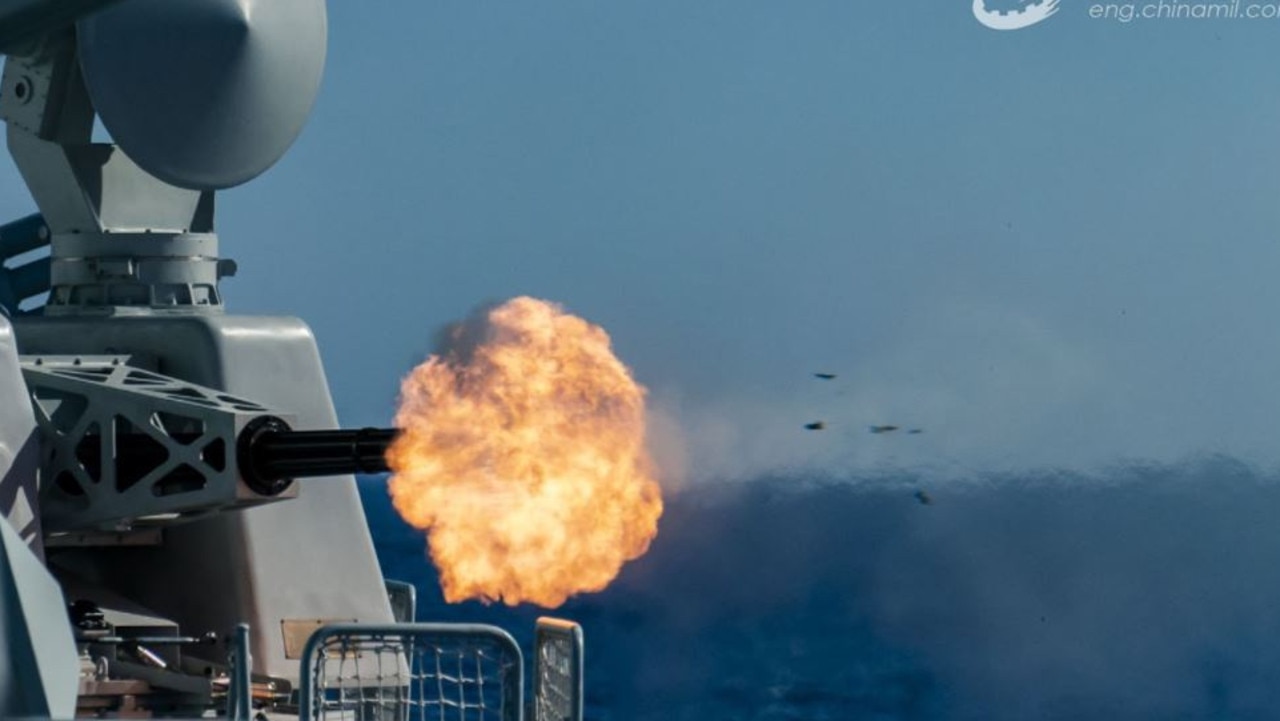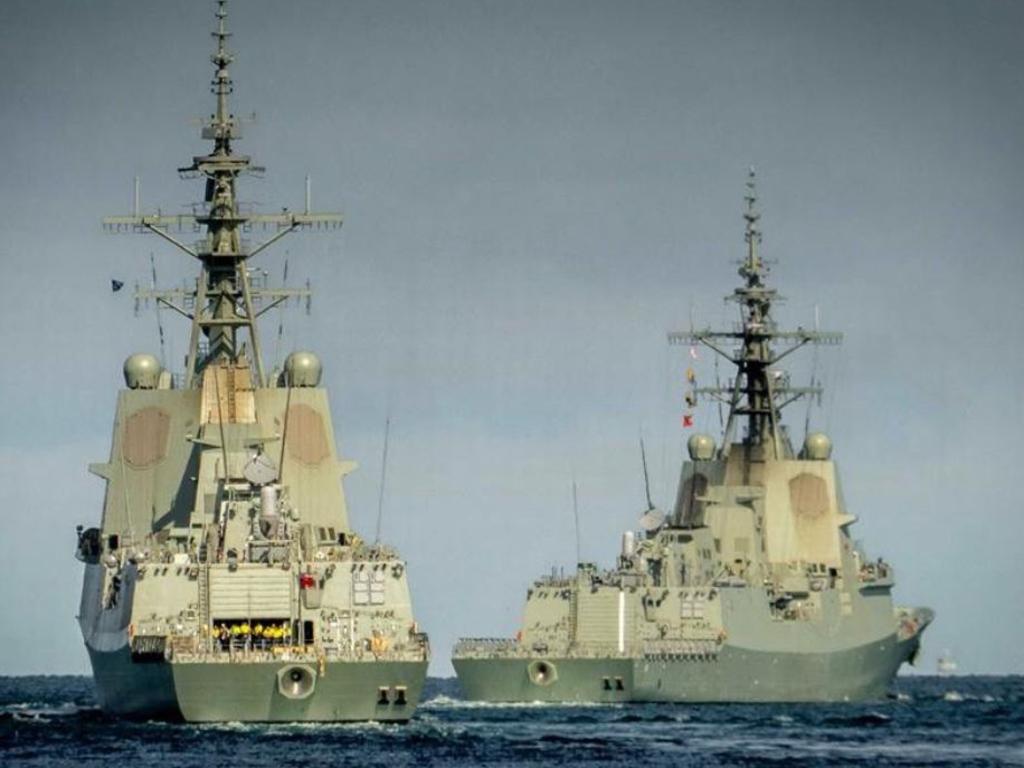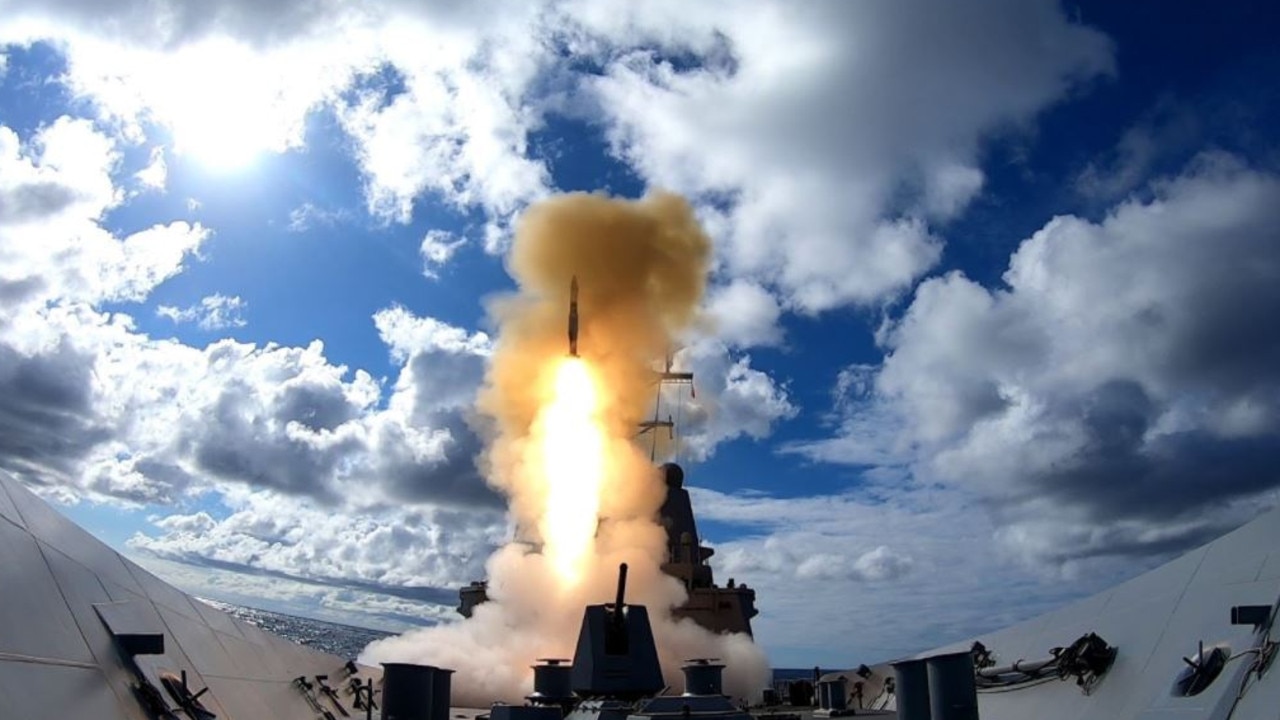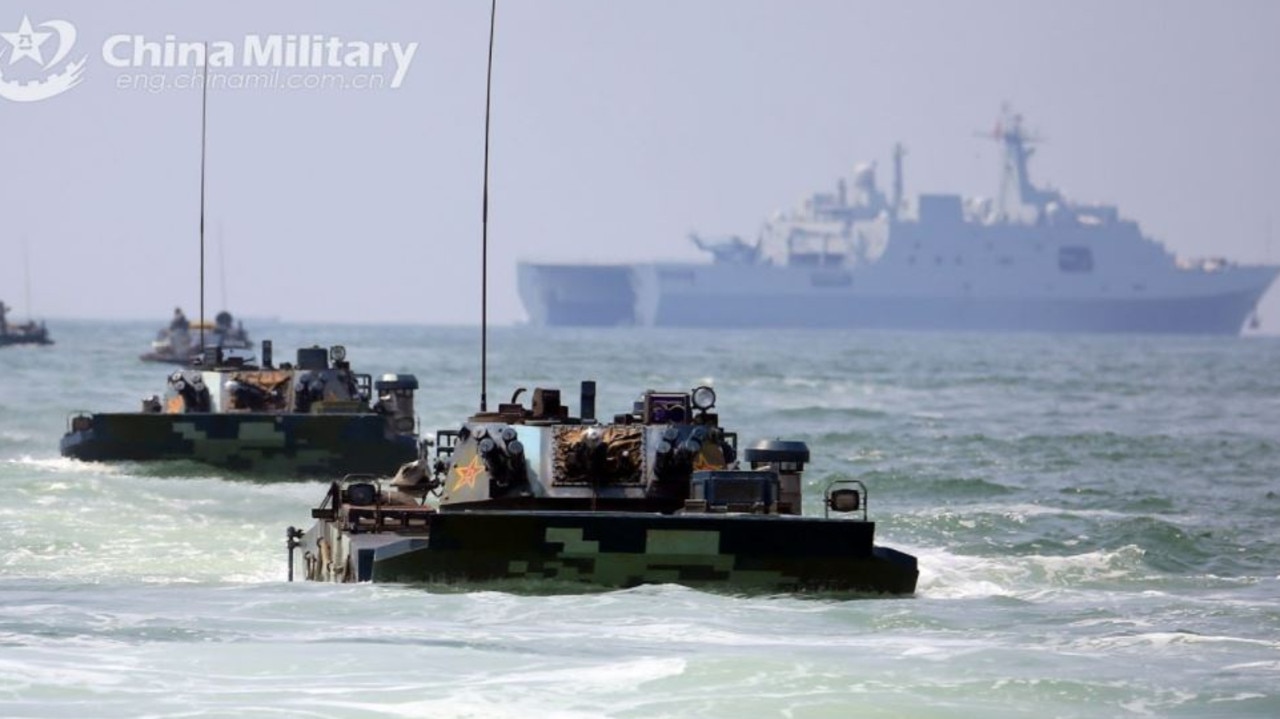What war between Australia and China could look like if Taiwan conflict escalates
The idea sounds grand – charging forth, flags flying, to save a bullied island friend. But China’s been preparing for this for decades.
Blood, sweat and tears. Is Australia prepared to pay the price to defend its friend Taiwan from China? And what would such a fight look like?
The vision is not a new one: White knights charging forth, flags flying, to save friends from a bellowing dragon. But China’s been preparing to take – and hold – Taiwan by force for decades. It has just about every contingency covered. And the West may not be able to do much about it.
Washington and Beijing are locked in an intense strategic battle.
The feud over the reigns of global influence is playing out in Southeast Asia. And the protagonists are testing each other’s resolve on an almost daily basis.
All it would take is one wrong move. One accident. One real threat mistaken for a bluff.
And, if a shooting war does break out, the US and its allies are not guaranteed a win.
“We cannot lose a single inch of the lands we inherited from our ancestors,” the Chinese Defense Ministry’s Information Bureau recently proclaimed, “and we would not take a single cent of others’ possessions.”
RELATED: ‘Drums of war’: Ominous China warning

But the definition of ancestral territory appears to be changing rapidly. It now overlaps the “ancestral” territory of Japan, Vietnam, the Philippines, Borneo and India.
The most immediate fight, however, appears to be centred on Taiwan. This last outpost of pre-Communist China is an embarrassing thorn in Chairman Xi Jinping’s paw.
And he’s repeatedly expressed his willingness to go to war to remove it.
Now, he can.
The Pentagon’s latest threat assessment found “China has already achieved parity with – or even exceeded – the United States in several military modernisation areas, including ship building, land-based conventional ballistic and cruise missiles, and integrated air defence systems.”
Beijing agrees.
The People’s Liberation Army is capable of “substantially subduing” the US Navy in the waters around China, a Communist Party-owned newspaper boasts.
And that is where any fight to resolve Taiwan’s fate will be resolved.
RELATED: ‘It will be bloody’: Threat to China

Trigger effect could lead to war
War could start in a multitude of ways.
An accident could trigger a cycle of escalation.
Fishing boats could push into “ancestral” territory, backed up by armed coast guard vessels.
An embarrassed politician may suddenly feel compelled to enforce a vague ‘red line’.
What follows would likely happen fast.
Beijing has already put its assets in place.
“China’s ‘grey zone’ strategy is designed to use fishing fleets to swarm disputed waters in the East and South China Sea, now supported by armed Chinese Coast Guard cutters leveraging their status as ‘non-combatants’ to get in close and be able to overwhelm US Navy warship sensors and defence perimeters,” former navy intelligence director James Fanell told US media.
The almost daily probes of Taiwan’s air defences would suddenly turn serious. Mock attacks will no longer be fake. Critical assets – such as radars and airfields – will immediately be targeted.
And Beijing’s new navy has been in almost a constant string of ‘live fire’ exercises for the past year. Imaginary targets could quickly be replaced by real ones.

“It is very plausible to say there is no guarantee of victory in the first phases,” Lyle Goldstein, a research professor at the Naval War College’s China Maritime Studies Institute, told Newsweek.
“I think China now has adequate forces, including air, missile, electronic warfare, spec ops, naval, undersea and nuclear, to likely prevail in the first phase and perhaps in subsequent phases too.”
What could be Australia’s role?
War over Taiwan would be “disastrous”, Australia’s chief of defence General Angus Campbell told a recent gathering.
“Conflict over the island of Taiwan would be a disastrous experience for the peoples of the region, and it’s something that we should all work to avoid. There is a pathway to a future through peaceful dialogue, but it’s a hard path, and it needs to be worked.”
But, his hawkish new boss, Defence Minister Peter Dutton, says war with China should not be “discounted”.
Beijing’s response was prompt and predictable. “We hope that Australia will fully understand the high sensitivity of the Taiwan issue, adhere to our One China principle, be cautious in its words and actions, refrain from sending any wrong signals to the secessionist forces of Taiwan independence,” a foreign ministry spokesperson said.
Australia’s role in such a significant potential conflict has been the subject of intense debate in recent years.
“Failing to come to Taiwan’s aid would seriously weaken and perhaps destroy America’s position in Asia, and our alliance with America would be seriously weakened if not destroyed if we failed to support the US. But it doesn’t follow that either America or Australia should therefore go to war with China to defend Taiwan,” Professor Hugh White noted in 2019.
“I think it’s clear that Australia would be better off staying out of it. Iraq should have taught us that it makes no sense to support an ally in a war it can’t win, and the stakes are much higher this time.”
Australian Strategic Policy Institute (ASPI) analyst Dr Malcolm Davis disagrees.
“Principles matter,” he writes. “As Australia enjoys all the benefits of a free and open society in a stable and functioning democracy, our principles and values must extend to supporting the survival of Taiwan.”
But is Taiwan’s fate any of our business, as Beijing insists it isn’t?
“To accept that argument as policy would mark the end of our strategic alliance with the US, leaving us more exposed to Chinese coercive pressure and political warfare, or even a direct military threat,” Dr Davis says.
Opening moves
Former defence minister, Christopher Pyne, told an audience in Adelaide that Taiwan was the “most likely next flashpoint in the region”.
“[A war is] something that you and I may well have to confront in the next five to 10 years,” he said.
At least initially, the bulk of any such conflict would be at sea.
And Australia could be fighting for its survival.
Australia is especially exposed. Despite decades of warnings, our fuel refineries continue to close. No emergency stockpiles have been established onshore. We don’t own cargo ships to force vital supplies through any blockade.

Such concerns must be overcome before any aid can be offered to our allies.
And Beijing has the advantage of geography.
Taiwan is much closer to China than the United States. And a mountain range makes it hard to reinforce via its eastern shores.
China’s airfields, naval ports and missile bases are all nearby. The US must operate from a few exposed facilities such as Okinawa and Guam. Its military planners already expect these to be overwhelmed by missiles in the opening hours of any conflict.
That leaves its navy as its primary fighting force.
But it is already outnumbered. And doesn’t have the necessary reach.
“Beyond out-producing the US Navy in the number of warships at a rate of four to one, the PLA Strategic Rocket Force has put US aircraft carriers at risk with the fielding of the DF-21D and DF-26 anti-carrier ballistic missiles,” Mr Fanell said.
Modern warships carry only a limited number of weapons. Vertical launch systems (VLS) are the modern-day equivalent of the World War II-era big gun. China’s new Type-055 “destroyers” can carry 112 large missiles. The US Arleigh Burke-class “destroyers” hold 96. Australia’s “Air Warfare Destroyers” pack just 42. And they cannot be rearmed at sea.

This means any idea of sustained operations within the Pacific-spanning reach of China’s ballistic and cruise missiles is likely optimistic. And that makes the kind of island-hopping campaign used by the US to take back the Pacific from Japan in World War II no longer feasible.
Tyranny of distance
Earlier this month, the United States Air Force staged a demonstration involving four heavily armed F-16 fighters. These flew out of Japan and down the east coast of Taiwan to operate near the USS Theodore Roosevelt carrier battle group – and the Chinese Liaoning.
But it took four vulnerable tanker aircraft to ‘carry’ them over that 6000km round trip. An F-16’s normal operational radius is usually about 600km.
It’s a problem long recognised by defence analysts and planners.
Modern aircraft – particularly the F-35 stealth fighters in Australia’s arsenal – need tender loving care. That means large paved airfields, humidity-controlled hangars and AI-enhanced maintenance equipment.
Those are easy targets. Especially without comprehensive and numerous missile defence systems.
And given Beijing’s singular focus on finding a way to sink US-style aircraft carriers, their capacity to carry combat aircraft into effective range has been dramatically curtailed. Even with robotic flying tanker support, these enormous ships must operate dangerously close to an enemy before their F-18 “Super Hornets” and F-35B&C “Lightnings” are of any use.

And that’s precisely the same vulnerability that saw obsolete battleships sent to the bottom so quickly during World War II.
Beijing’s tactic of “area denial” already appears to have been effective.
Its artificial island fortresses are unsinkable outposts. And each one would require a heavy investment of equipment and lives to neutralise – if they could be reached in the first place.
Which is why Dr Davis argues any conflict would likely focus on two strategic waterways – the Bashi Channel and Miyako Strait – that guard the China Seas.
Strategic objectives
“Chinese strategists see these passages as crucial to their ability to deploy forces beyond the first island chain,” analyst Ben Lowsen told The Diplomat. “Some strategists even use an east-facing map with China at the bottom to show China as being encircled and needing to break out.”
The Bashi Channel connects the South China Sea with the Pacific Ocean. It runs between the Philippines and Taiwan.
The Miyako Strait connects the East China Sea with the Pacific Ocean. It runs between the Japanese islands of Mikako and Okinawa.
These waterways could be used to “bottle up” Chinese forces. Which is why Beijing would be so determined to secure them.
And Taiwan – sitting neatly between the two – offers that opportunity.
“From Taiwan, the PLA could also pivot south, effectively enveloping the Philippines and giving Beijing easier access to the resource-rich Benham Rise,” Dr Davis writes. “Chinese control of Taiwan would also strengthen Beijing’s ability to control the South China Sea by blocking the Luzon Strait and the Balintang and Babuyan channels…
“Control of Taiwan would make it easier for the PLA to reach Guam using long-range missiles and air power, extending its anti-access capabilities beyond the first island chain.”
And that would leave Australia’s critical fuel supply links to Singapore desperately exposed.
Reinforcing Taiwan would likely involve long and bloody battles at sea as underarmed escorts struggle to protect the few – but highly vulnerable – available transports. Western submarines will play a role in restraining China’s surface fleet. But its own submarines, combined with air and land launched missiles, could present an almost constant threat.
In such a scenario, any Australian task force centred on its largely undefended troop transports and limited warship escorts would be under extreme risk. They would be forced to operate as part of a much greater allied unit.
“America’s military power is very great, but China’s military power, and especially its capacity to deny its air and sea approaches to US forces, has grown sharply, and is now formidable,” Professor White warned.
Jamie Seidel is a freelance writer | @JamieSeidel




